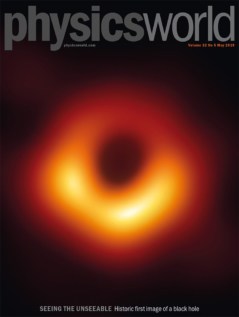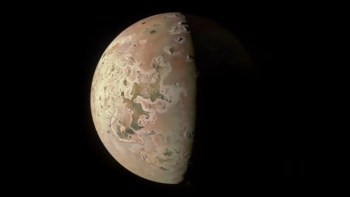It’s time to tuck into the May 2019 issue of Physics World magazine, which is now out in print and digital formats.
We couldn’t resist putting on the cover last month’s historic first-ever image of a black hole, captured by astronomers from the Event Horizon Telescope (see below). It’s an iconic image and one that print readers will love to get in their hands.

However, that breakthrough, which we discuss in the new issue, shouldn’t overshadow the thought-provoking feature by Lincoln Carr – a physicist at the Colorado School of Mines who thinks scientists can become better researchers by embracing the ambiguity inherent in the arts.
As he explains in this feature in the May edition, Carr is putting his ideas into practice by teaching his students to acquire new cognitive skills and unlock their creativity through poetry, mind-mapping, and “cognitive debate”. Find out more by watching the video above or listening to in this podcast.
Elsewhere in the issue, you can find out how the GRACE-FO satellites “weigh” water from space, explore the use of nanoparticles in medicine, read an interview with Nobel laureate Kostya Novoselov – and discover why the physicist Elon Musk is (mostly) so good at business.
You can enjoy the May 2019 issue of Physics World magazine via our digital apps for iOS, Android and Web browsers (membership of the Institute of Physics required). Let us know what you think about the issue on Twitter, Facebook or by e-mailing us at pwld@iop.org.
For the record, here’s a run-down of what’s in the issue.
• First black hole images unveiled – The Event Horizon Telescope has taken the first-ever images of a black hole, a breakthrough that lets astronomers study the event horizon of supermassive black holes. Michael Banks reports
• A 3D view on 2D materials – Nobel laureate Kostya Novoselov from the University of Manchester, UK, talks to Anna Demming about moving on from graphene and going back into 3D materials
• A question of timing – Elon Musk’s involvement in commercial space flight and electric vehicles underlines why getting your timing right is vital in business, says James McKenzie
• QB or not QB – Philosophers can learn much from a row in the physics community, says Robert P Crease
• Learning through interacting – Nikola Šibalic says that physicists can improve how they communicate their results by using interactive figures
• Weighing water from space – By monitoring tiny changes to the Earth’s gravitational field, the GRACE satellites have been pinpointing the distribution of fresh water on our planet for almost two decades. But as Marric Stephens explains, a new follow-on mission is also helping with plans for a space-based gravitational-wave detector
• Learning to be astonished – We’re often taught to think of science and the humanities as discrete fields, with the former full of definite truths and the latter open to interpretation. But is that really the case? Lincoln Carr explains how he’s helping science students use the ambiguity essential to the humanities to become better researchers
• Nanoparticles home in on infectious diseases – A new wave of “bionanosensors” may make it quicker, cheaper and easier to detect harmful microorganisms, but hurdles remain before they can enter the clinical realm, as Joe McEntee reports
• Across the universe – Melissa Brobby reviews The Beginning and the End of Everything: From the Big Bang to the End of the Universe by Paul Parsons
• Coupled practices – Anna Demming reviews Physics and Dance by Emily Coates and Sarah Demers
• The art of continuous transformation – How does an industrial physicist end up in an arts faculty working on historic printing processes – and why? Susanne Klein tells Joe McEntee all about it
• Once a physicist – Meet David Roberts, a co-founder of 110th Street Films, is a writer and filmmaker who previously he worked as a US diplomat
• Physicist in the making – Peter Wright explores what first got him into physics as a youngster



